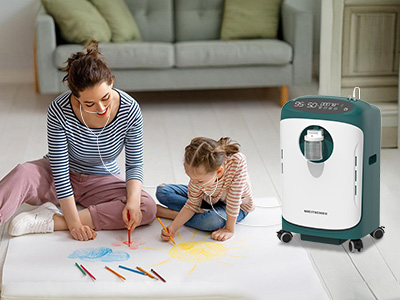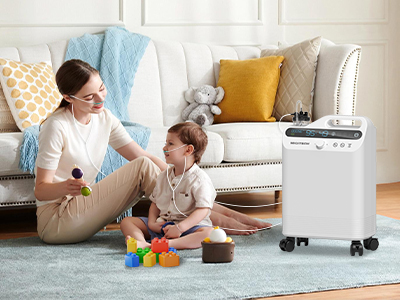30 Jun 2025
When it comes to children, the only predictable thing is unpredictability. Add home oxygen therapy into the mix, and suddenly, the stakes get a little higher and the learning curve a little steeper. One minute you're reading bedtime stories, the next you're checking oxygen saturation with one hand and Googling “portable backup oxygen tank” with the other.
Emergencies don’t RSVP. Power outages, equipment failures, natural disasters, or even a toddler with unusually advanced unplugging skills—they all have a knack for showing up uninvited. So how do you prepare when your child relies on oxygen therapy and chaos is lurking just outside the nursery door?
Simple: you build a plan that’s part strategy, part superhero cape, and all about keeping calm when everything else isn’t.

Know the Risks Before They Knock
Before you can plan for emergencies, you need to know which kinds are most likely to rear their disruptive little heads. Not all disasters wear capes—some come dressed as everyday inconveniences.
Power Outages: The villainous classic. Your concentrator runs on electricity. No power? No oxygen. You can almost hear the dramatic music.
Equipment Malfunctions: Machines, like toddlers, sometimes stop working with zero warning. Alarms, leaks, or tubing disconnections can become crises if not caught early.
Natural Disasters: Hurricanes, wildfires, earthquakes, snowstorms. Each one brings its own flavor of inconvenience, with bonus rounds of “where did I put the backup batteries?”
Medical Emergencies: Respiratory infections, unexpected desaturations, or a sudden need for hospitalization—always lurking around the corner with poor timing.
Step one in preparedness: knowing your enemies. Step two? Planning like a general in a tiny, oxygen-fueled army.
Build the Ultimate Emergency Oxygen Kit
This isn’t your average diaper bag. This is the survivalist cousin—the one with duct tape, triple-A batteries, and three backup plans for everything.
Must-Haves:
Backup Oxygen Source: Portable oxygen tanks or battery-powered concentrators that can keep your child breathing when the main unit powers down.
Fully Charged Batteries: And extra batteries, because the moment you only bring one, it will die in protest.
Tubing & Cannulas: More than one set. Think "backup for your backup."
Pulse Oximeter: To keep tabs on your child’s oxygen levels and avoid guessing whether that shade of blue is cause for concern.
Oxygen Wrench or Key: Because some tanks need old-school tools to open—and those tools have a habit of vanishing in emergencies.
Medical Information Sheet: Laminated, clearly written, and including your child’s diagnosis, medication list, oxygen settings, and emergency contacts.
Manual Nebulizer (if applicable): For children with concurrent respiratory conditions, in case the power-hungry one decides to nap.
Face Masks (for both oxygen delivery and public settings): One size for the child, one for you, because germs don’t take snow days.
Bonus points if your kit is in a bright-colored bag you can grab blindfolded at 3 AM while still half-dreaming about talking ducks.
Power Failure Plans: When the Lights Go Out
Electricity is great… until it isn’t. Then it’s a race against the battery indicator.
Alert Your Power Company: Many utilities have a medical priority registry. This won’t prevent outages, but it might get you back online faster—or at least give you a courtesy call before planned outages.
Battery Backup Systems: Invest in an uninterruptible power supply (UPS) for your concentrator or a portable battery pack rated for medical devices.
Generator (With Caution): If you go the generator route, follow every single safety guideline. Keep it outside, never indoors, and ensure it's up to code. Carbon monoxide is not part of your child’s care plan.
Know Your Runtime: Be familiar with how long your battery lasts at your child’s flow setting. “It should last a while” is not a plan. “It runs for 5 hours on 2L/min and I’ve got two spares” is.
Have a Go-Bag for Fast Escapes
Sometimes, emergencies don’t wait for you to tie your shoes. Evacuations happen. When they do, your go-bag becomes your oxygen-filled lifeline.
Essentials:
Portable Oxygen System (with adequate supply)
Medical Information (hard copy + digital backup on your phone)
Favorite Comfort Item (for child): Blankie, stuffed animal, or whatever helps them feel safe.
Basic Supplies: Water, snacks, diapers, wipes, extra clothes, medications.
Phone Charger & Power Bank: Emergencies love to hit when your phone is at 3%.
Stash this bag by the door or in your car. And yes, go ahead and practice a drill once in a while—like fire drills, but with less yelling and more oxygen management.

Communicate the Plan (And Rehearse It)
You might be the hero of this emergency plan, but even superheroes need sidekicks.
Educate Family and Caregivers: Everyone who watches your child—even for five minutes—should know the basic oxygen protocol and where the emergency supplies are.
Create a Simple Written Plan: Use bullet points. Include step-by-step instructions for what to do in various scenarios.
Practice Scenarios: Run through situations like “power goes out,” “child pulls off tubing,” or “you have 5 minutes to evacuate.” Make it a game for older kids, and a practice run for adults.
Clarity is survival. When panic hits, muscle memory and laminated instructions are your best friends.
Emergency Contacts and Medical Allies
Your emergency prep should include a tight-knit squad of phone-a-friends.
Pediatrician & Pulmonologist Numbers: Program them into your phone and write them on the emergency info sheet.
Medical Equipment Provider: In case your oxygen concentrator stages a rebellion at 2 AM.
Local Hospital with Pediatric Respiratory Services: Know where to go, and how to get there fast.
911 Cheat Sheet: If your child has complex needs, keep a pre-written script by the phone: "My child is oxygen-dependent and desaturates quickly. We use 2L nasal cannula. Please bring pediatric support."
When seconds matter, clarity beats improvisation every time.
Emotional Preparedness: Calm is Contagious
Children take their cues from the adults around them. In emergencies, your calmness is their comfort.
Stay Centered: Breathe (you too!), move deliberately, and speak in soothing tones—even when your brain is sprinting.
Practice Breathing Techniques Together: Yes, even for the child on oxygen. Controlled breathing, distraction games, and comfort strategies all help.
Celebrate Preparedness, Not Fear: Talk about your emergency kit like it’s a superhero backpack, not a doom-bag. Frame it as empowerment, not panic.
Preparedness isn't about predicting doom. It's about knowing you'll be okay, no matter what.
Keywords: oxygen therapy
Originally published 30 Jun 2025, updated 30 Jun 2025.